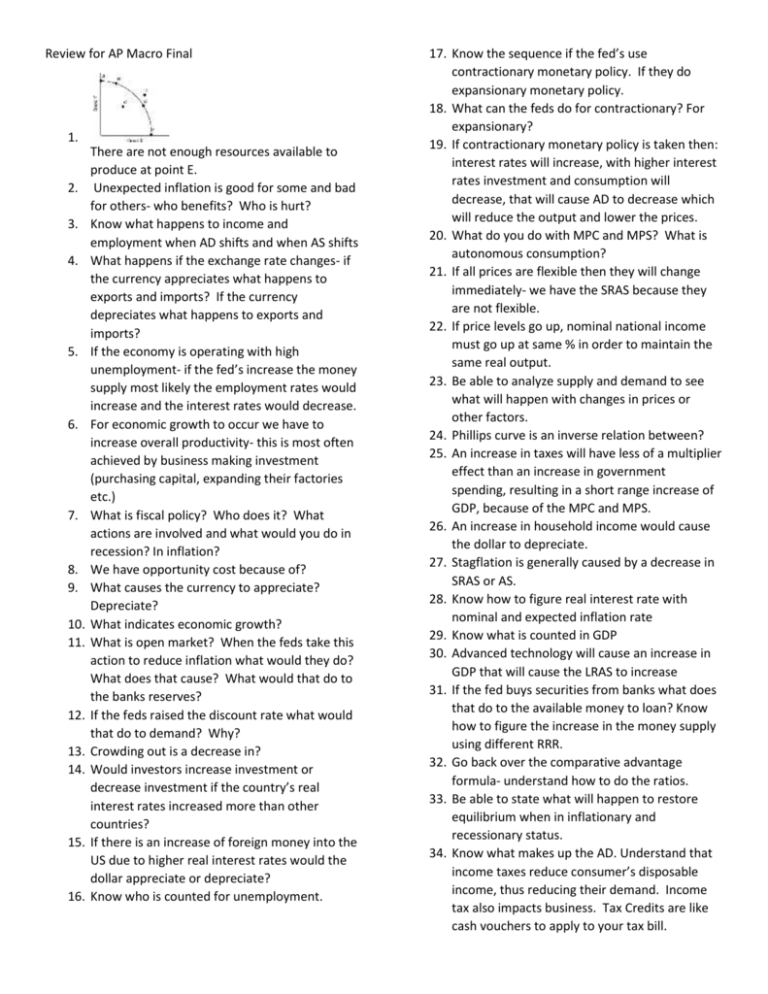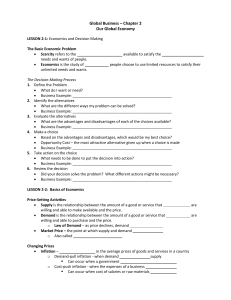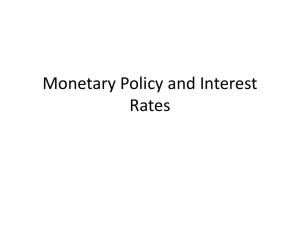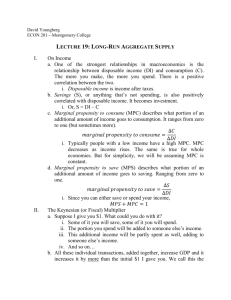Review Objective AP Final
advertisement

Review for AP Macro Final 1. 2. 3. 4. 5. 6. 7. 8. 9. 10. 11. 12. 13. 14. 15. 16. There are not enough resources available to produce at point E. Unexpected inflation is good for some and bad for others- who benefits? Who is hurt? Know what happens to income and employment when AD shifts and when AS shifts What happens if the exchange rate changes- if the currency appreciates what happens to exports and imports? If the currency depreciates what happens to exports and imports? If the economy is operating with high unemployment- if the fed’s increase the money supply most likely the employment rates would increase and the interest rates would decrease. For economic growth to occur we have to increase overall productivity- this is most often achieved by business making investment (purchasing capital, expanding their factories etc.) What is fiscal policy? Who does it? What actions are involved and what would you do in recession? In inflation? We have opportunity cost because of? What causes the currency to appreciate? Depreciate? What indicates economic growth? What is open market? When the feds take this action to reduce inflation what would they do? What does that cause? What would that do to the banks reserves? If the feds raised the discount rate what would that do to demand? Why? Crowding out is a decrease in? Would investors increase investment or decrease investment if the country’s real interest rates increased more than other countries? If there is an increase of foreign money into the US due to higher real interest rates would the dollar appreciate or depreciate? Know who is counted for unemployment. 17. Know the sequence if the fed’s use contractionary monetary policy. If they do expansionary monetary policy. 18. What can the feds do for contractionary? For expansionary? 19. If contractionary monetary policy is taken then: interest rates will increase, with higher interest rates investment and consumption will decrease, that will cause AD to decrease which will reduce the output and lower the prices. 20. What do you do with MPC and MPS? What is autonomous consumption? 21. If all prices are flexible then they will change immediately- we have the SRAS because they are not flexible. 22. If price levels go up, nominal national income must go up at same % in order to maintain the same real output. 23. Be able to analyze supply and demand to see what will happen with changes in prices or other factors. 24. Phillips curve is an inverse relation between? 25. An increase in taxes will have less of a multiplier effect than an increase in government spending, resulting in a short range increase of GDP, because of the MPC and MPS. 26. An increase in household income would cause the dollar to depreciate. 27. Stagflation is generally caused by a decrease in SRAS or AS. 28. Know how to figure real interest rate with nominal and expected inflation rate 29. Know what is counted in GDP 30. Advanced technology will cause an increase in GDP that will cause the LRAS to increase 31. If the fed buys securities from banks what does that do to the available money to loan? Know how to figure the increase in the money supply using different RRR. 32. Go back over the comparative advantage formula- understand how to do the ratios. 33. Be able to state what will happen to restore equilibrium when in inflationary and recessionary status. 34. Know what makes up the AD. Understand that income taxes reduce consumer’s disposable income, thus reducing their demand. Income tax also impacts business. Tax Credits are like cash vouchers to apply to your tax bill. 35. Know the difference between the types of unemployment. 36. Marginal propensity to consume is used to determine the spending multiplier. 37. Know the monetary tools and which way they go to increase and decrease the money supply, as well as what action to use when in recession or in inflation. 38. Understand what Full employment, full output indicate as well as above and below. 39. Know the fiscal policy tools and which way they work. 40. Understand that monetary is Federal Reserve and fiscal is government. 41. Remember that Price level is also referring to inflation. 42. There are times that the Fed’s will take expansionary actions while the government uses contractionary action- this would seem counterproductive. However, the Fed’s actions to increase the MS would lower the interest rates while the government’s actions would lower the price levels. Combined these two could result in maintaining the price level but encourage investment. 43. Firms could decrease production cost by increasing their output. 44. Know the formula for the unemployment rate 45. When a country increases its money supply, inflation increases. 46. Know your formula for MPC and the multiplier 47. Fiat money has no intrinsic value 48. Demand pull inflation 49. Nominal GDP and Real GDP with an increase in money supply 50. When a company has a decrease in labor productivity then they will decrease supply because now it is causing them more to produce- in the short run. In the long run if productivity remained low then the LRAS would shift left. Things to remember GDP=C+I+G+X-IM Consumption is approximately 70% of GDP Go back over what is included in each of the parts of GDP- remember that only new items for that year. A new house is investment not consumption. Remember that investment does not mean stocks and bonds for the GDP. The Federal Reserve uses its tools to increase and decrease interest rates- the ultimate target that they are aiming for is the Federal Funds Rate- this is the rate that banks charge other banks to borrow short term. The Fed’s cannot actually change the rate, they can only change the supply of money which should change interest rates, which should change investment. Remember the spending multiplier- 1/1-MPC MPC+MPS=1 MPC= change in consumer spending/change in DI The tax multiplier is always less than the spending multiplier- people do not increase consumption immediately. While higher interest rates will reduce the amount of investment in the country it encourages international inflow of capital. (foreign countries will invest cash in countries with higher interest rates) Foreign exchange: think of currency from one country to another like the tokens at different restaurants. You have to have the right token to buy the games. If the exchange rate is 1$ = 4 tokens and then a token machine started giving out 10 tokens for a $ that would increase demand for that machine (countries exports) That $ had appreciated in value and the demand increases. With appreciation imports increases. If the machine gave 2 tokens for a $ it would have depreciated in value, less demand, fewer dollars converted and imports would fall so net exports would increase. Appreciation and depreciation is about what it will buy in another country. When one country appreciates then the other country depreciates. Foreign exchange impacts GDP by the net exports. A stronger $ means imports increase and exports decrease so net exports decreases and causes GDP to decrease.









